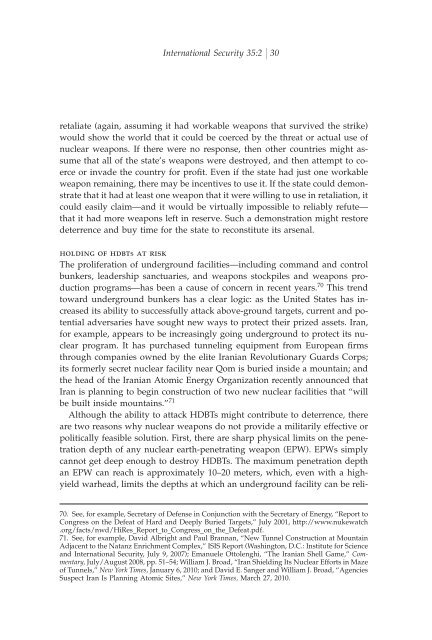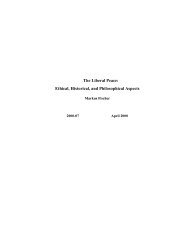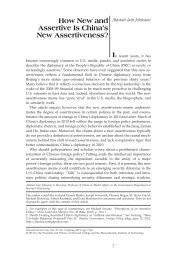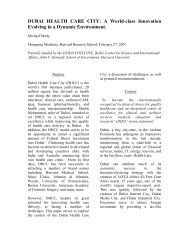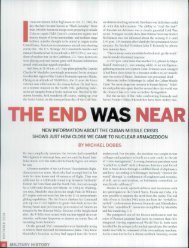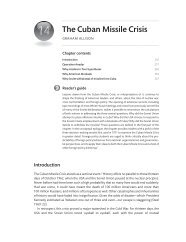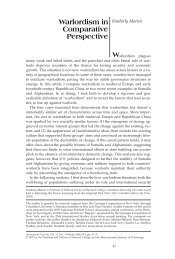The Next Step for U.S. Nuclear Policy - Project MUSE
The Next Step for U.S. Nuclear Policy - Project MUSE
The Next Step for U.S. Nuclear Policy - Project MUSE
You also want an ePaper? Increase the reach of your titles
YUMPU automatically turns print PDFs into web optimized ePapers that Google loves.
International Security 35:2 30<br />
retaliate (again, assuming it had workable weapons that survived the strike)<br />
would show the world that it could be coerced by the threat or actual use of<br />
nuclear weapons. If there were no response, then other countries might assume<br />
that all of the state’s weapons were destroyed, and then attempt to coerce<br />
or invade the country <strong>for</strong> proªt. Even if the state had just one workable<br />
weapon remaining, there may be incentives to use it. If the state could demonstrate<br />
that it had at least one weapon that it were willing to use in retaliation, it<br />
could easily claim—and it would be virtually impossible to reliably refute—<br />
that it had more weapons left in reserve. Such a demonstration might restore<br />
deterrence and buy time <strong>for</strong> the state to reconstitute its arsenal.<br />
holding of hdbts at risk<br />
<strong>The</strong> proliferation of underground facilities—including command and control<br />
bunkers, leadership sanctuaries, and weapons stockpiles and weapons production<br />
programs—has been a cause of concern in recent years. 70 This trend<br />
toward underground bunkers has a clear logic: as the United States has increased<br />
its ability to successfully attack above-ground targets, current and potential<br />
adversaries have sought new ways to protect their prized assets. Iran,<br />
<strong>for</strong> example, appears to be increasingly going underground to protect its nuclear<br />
program. It has purchased tunneling equipment from European ªrms<br />
through companies owned by the elite Iranian Revolutionary Guards Corps;<br />
its <strong>for</strong>merly secret nuclear facility near Qom is buried inside a mountain; and<br />
the head of the Iranian Atomic Energy Organization recently announced that<br />
Iran is planning to begin construction of two new nuclear facilities that “will<br />
be built inside mountains.” 71<br />
Although the ability to attack HDBTs might contribute to deterrence, there<br />
are two reasons why nuclear weapons do not provide a militarily effective or<br />
politically feasible solution. First, there are sharp physical limits on the penetration<br />
depth of any nuclear earth-penetrating weapon (EPW). EPWs simply<br />
cannot get deep enough to destroy HDBTs. <strong>The</strong> maximum penetration depth<br />
an EPW can reach is approximately 10–20 meters, which, even with a highyield<br />
warhead, limits the depths at which an underground facility can be reli-<br />
70. See, <strong>for</strong> example, Secretary of Defense in Conjunction with the Secretary of Energy, “Report to<br />
Congress on the Defeat of Hard and Deeply Buried Targets,” July 2001, http://www.nukewatch<br />
.org/facts/nwd/HiRes_Report_to_Congress_on_the_Defeat.pdf.<br />
71. See, <strong>for</strong> example, David Albright and Paul Brannan, “New Tunnel Construction at Mountain<br />
Adjacent to the Natanz Enrichment Complex,” ISIS Report (Washington, D.C.: Institute <strong>for</strong> Science<br />
and International Security, July 9, 2007); Emanuele Ottolenghi, “<strong>The</strong> Iranian Shell Game,” Commentary,<br />
July/August 2008, pp. 51–54; William J. Broad, “Iran Shielding Its <strong>Nuclear</strong> Ef<strong>for</strong>ts in Maze<br />
of Tunnels,” New York Times, January 6, 2010; and David E. Sanger and William J. Broad, “Agencies<br />
Suspect Iran Is Planning Atomic Sites,” New York Times, March 27, 2010.


